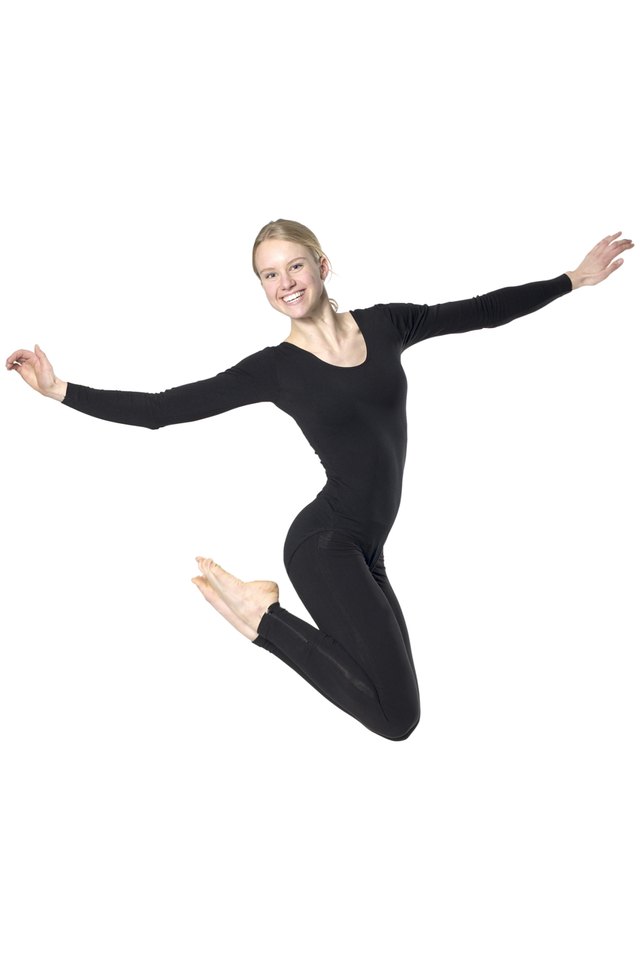Examples of a High & Low Impact Dance

High- and low-impact dancing are terms used to describe aerobic workouts. Dance aerobics became popular in the 1970s when instructors began to combine dance moves and athletic moves and set them to music. Dance workouts became more and more popular in the early years of the 21st century, with fitness centers adding classes incorporating jazz, hip-hop and Latin beats, plus tap, ballet and other dance moves. The trend has moved toward low-impact workouts, since high-impact workouts are associated with a greater incidence of injuries and potential injuries.
Low-Impact Dance Aerobics
The basic rule in low-impact dance is that one foot always remains on the ground. Standard moves in low-impact dance workouts include quick lateral steps and forward and back steps combined with toe touches. For example, you take a step to the side with your left foot and then bring you right foot in the same direction, touching the toe of your right foot to the ground instead of planting your foot. Other forms of low-impact aerobics incorporate forms of martial arts, such as kickboxing, yoga and weights into the dance routines.
High-Impact Dance Aerobics
High-impact dance aerobics includes elements such as jumping jacks, simulated jump-roping and other forms of leaping with both feet off the ground. Step-aerobic moves can be either low or high-impact, depending on the speed and height of the steps you are using. As with other forms of high-impact exercise, such as running, high-impact dance aerobic moves put more stress on the joints, tendons and ligaments of your lower body.
Research
Research reported in the "Journal of Applied Biomechanics" that studied the impact forces of striking the ground, found that low-impact knee lifts impose significantly less impact that high-impact moves. Another study, reported in the "Journal of Sports Medicine and Physical Fitness," examined eight experienced aerobic dance instructors who incorporated 10 high-impact and 10 low-impact moves in their classes. Researchers concluded that low-impact dance might be better for decreasing the incidence of lower extremity overuse injuries.
Considerations
The American Academy of Podiatric Sports Medicine strongly recommends using sport-specific shoes if you take aerobic dance classes. Otherwise, you run the risk of developing such injuries as plantar fasciitis, shin splints and stress fractures. Shoes need to provide stability for lateral movements and sufficient cushioning and shock absorption, especially if you are involved in high-impact dance classes. The right shoes also help if you have feet with excessively high or low arches. For those who prefer the greater intensity of high-impact dance classes without as many safety risks, combo classes that use both high and low-impact moves are an appropriate choice.
References
- IDEA Health & Fitness Association: Beyond the Bee Gees: From Dance Aerobics to Pilates, a Look at How the Fitness Scene Has Evolved
- Laser-Spine Institute: Low-Impact Athletic Conditioning
- Journal of Sports Medicine & Physical Fitness: Ground Reaction Forces in High Impact and Low Impact Aerobic Dance
- International Journal of Sports Biomechanics: Comparison of Impact Forces in High and Low Impact Aerobic Dance Movements
- American Academy of Podiatric Sports Medicine: What is Aerobic Dancing?
Writer Bio
This article was written by the CareerTrend team, copy edited and fact checked through a multi-point auditing system, in efforts to ensure our readers only receive the best information. To submit your questions or ideas, or to simply learn more about CareerTrend, contact us [here](http://careertrend.com/about-us).
